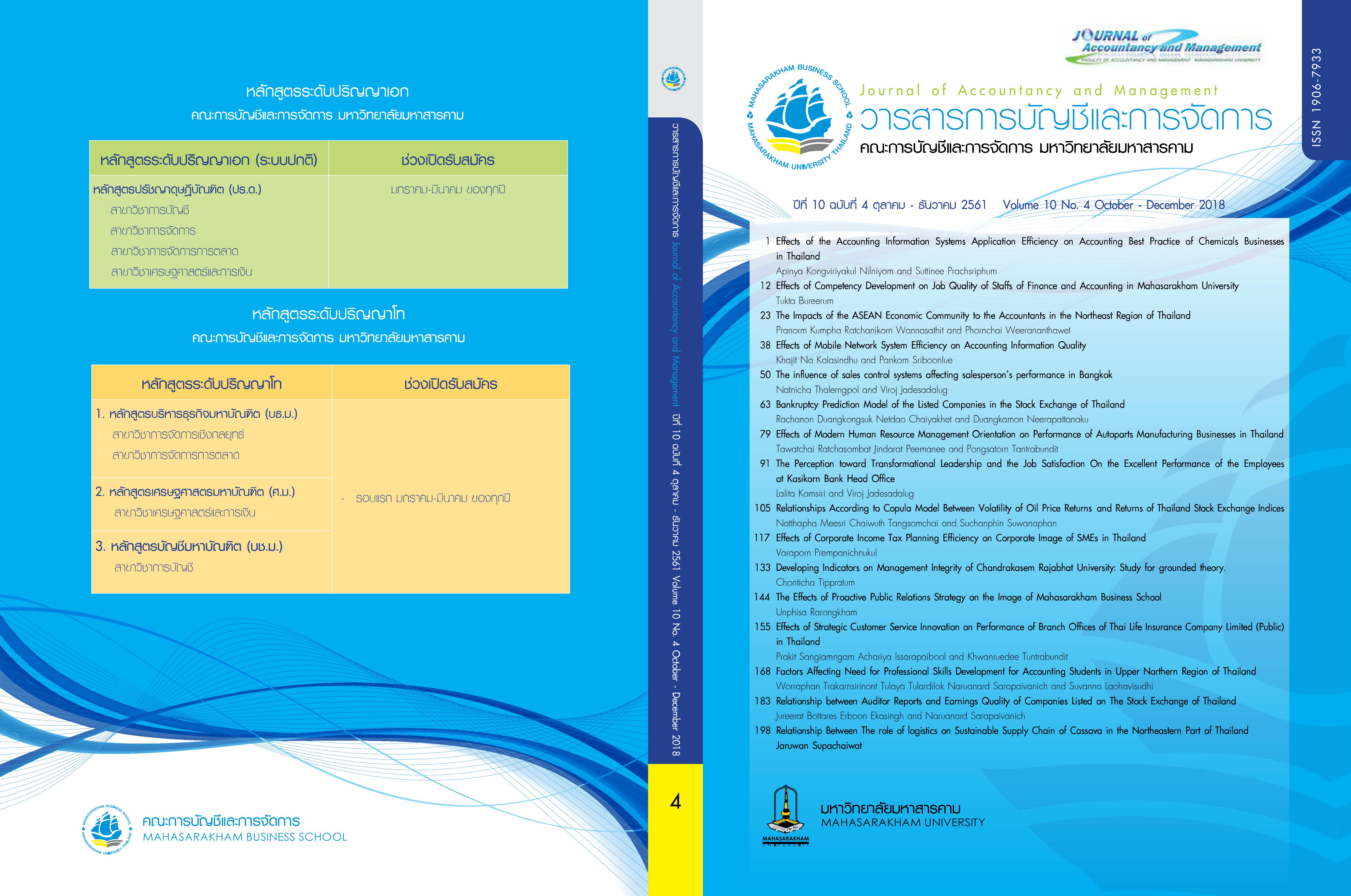ผลกระทบการมุ่งเน้นการจัดการทรัพยากรมนุษย์สมัยใหม่ที่มีต่อผลการดำเนินงานของธุรกิจผลิตชิ้นส่วนยานยนต์ในประเทศไทย
Main Article Content
บทคัดย่อ
การวิจัยครั้งนี้มีวัตถุประสงค์ เพื่อทดสอบผลกระทบการมุ่งเน้นการจัดการทรัพยากรมนุษย์สมัยใหม่กับผลการดำเนินงานของธุรกิจผลิตชิ้นส่วนยานยนต์ในประเทศไทย โดยใช้แบบสอบถามเป็นเครื่องมือในการเก็บรวบรวมข้อมูลจากผู้บริหารฝ่ายทรัพยากรมนุษย์ธุรกิจผลิตชิ้นส่วนยานยนต์ในประเทศไทย จำนวน 582 คน แบบสอบถามมีความสมบูรณ์ จำนวน 179 ชุด ได้ถูกนำไปใช้ในการวิเคราะห์ข้อมูล สถิติที่ใช้ในการวิเคราะห์ข้อมูล ได้แก่ การวิเคราะห์สหสัมพันธ์แบบพหุคูณ และการวิเคราะห์การถดถอยเชิงพหุคูณ ผลการวิจัย พบว่า การมุ่งเน้นการจัดการทรัพยากรมนุษย์สมัยใหม่ ด้านการพัฒนาองค์กร การจัดหาพนักงาน และด้านการให้รางวัล มีความสัมพันธ์และผลกระทบเชิงบวกกับผลการดำเนินงานโดยรวม ดังนั้น ผู้บริหารฝ่ายทรัพยากรมนุษย์ธุรกิจผลิตชิ้นส่วนยานยนต์ ควรนำข้อสนเทศ ที่ได้จากการวิจัยในครั้งนี้ไปใช้เป็นแนวทางในการบริหารจัดการด้านทรัพยากรมนุษย์ภายในองค์กรเป็นสำคัญและสามารถนำไปใช้เป็นแนวทางสำหรับการวางแผนพัฒนา และปรับปรุงการดำเนินงานขององค์กร รวมถึงการสร้าง กลยุทธ์ด้านการมุ่งเน้นจัดการทรัพยากรมนุษย์สมัยใหม่ของธุรกิจผลิตชิ้นส่วนยานยนต์ในประเทศไทย เพื่อเพิ่ม ศักยภาพการดำเนินงานขององค์กรให้มีประสิทธิภาพมากยิ่งขึ้น ประสบผลสำเร็จบรรลุตามวัตถุประสงค์ที่ตั้งไว้ซึ่งก่อให้เกิดประโยชน์สูงสุดต่อไปในอนาคต
Downloads
Article Details
บทความที่ได้รับการตีพิมพ์เป็นลิขสิทธิ์ของวารสารการบัญชีและการจัดการ
ข้อความที่ปรากฏในบทความแต่ละเรื่องในวารสารวิชาการเล่มนี้เป็นความคิดเห็นส่วนตัวของผู้เขียนแต่ละท่านไม่เกี่ยวข้องกับมหาวิทยาลัยมหาสารคาม และคณาจารย์ท่านอื่นๆในมหาวิทยาลัยฯ แต่อย่างใด ความรับผิดชอบองค์ประกอบทั้งหมดของบทความแต่ละเรื่องเป็นของผู้เขียนแต่ละท่าน หากมีความผิดพลาดใดๆ ผู้เขียนแต่ละท่านจะรับผิดชอบบทความของตนเองแต่ผู้เดียว
เอกสารอ้างอิง
สวทช. ค้นเมื่อ 20 กันยายน 2558, จาก http://www.nstda.or.th/industry/autoparts-industry
ชนิดา พันธะ. (2557). ความสัมพันธ์ระหว่างการพัฒนาทรัพยากรมนุษย์กับผลการปฏิบัติงานของบุคลากร
มหาวิทยาลัยเทคโนโลยีราชมงคลอีสาน. วิทยานิพนธ์ กจ.ม. มหาสารคาม : มหาวิทยาลัยมหาสารคาม.
นฤมล สุ่นสวัสดิ์. (2552). การพัฒนาประสิทธิภาพในการทำงาน (พิมพ์ครั้งที่ 1). กรุงเทพฯ : วันทิพย์.
พิชิต เทพวรรณ์. (2554). การจัดการทรัพยากรมนุษย์เชิงกลยุทธ์. (พิมพ์ครั้งที่ 1). กรุงเทพฯ : ซีเอ็ดยูเคชั่น.
เพ็ญนภา วรรณแก้ว. (2550). ความสัมพันธ์ระหว่างการจัดการทรัพยากรมนุษย์กับการพัฒนาการบัญชีทรัพยากร
มนุษย์ของบริษัทจดทะเบียนในตลาดหลักทรัพย์แห่งประเทศไทย. วิทยานิพนธ์ บช.ม. มหาสารคาม : มหาวิทยาลัยมหาสารคาม.
วิลาวรรณ รพีพิศาล. (2554). ความรู้พื้นฐานในการบริหารทรัพยากรมนุษย์ในการบริหารทรัพยากรมนุษย์. (พิมพ์ครั้งที่ 1). กรุงเทพฯ : วิจิตรหัตถกร.
ศุภชัย เมืองรักษ์. (2557). การวัดความสำเร็จขององค์กร. ค้นเมื่อ 25 พฤษภาคม 2557, จาก http://www.personnel.mju.ac.th/itm-admin/uploads/29078.doc
สมาคมผู้ผลิตชั้นส่วนยานยนต์ไทย. (2558.) ประวัติความเป็นมาของธุรกิจผลิตชิ้นส่วนยานยนต์. ค้นเมื่อ 18 กันยายน 2558, จาก http://www.thaiautoparts.or.th/about_us.php
สุดารัตน์ ชิณะทรัพย์. (2558). กระแสโลกในยุคโลกาภิวัตน์. ค้นเมื่อ 21 กันยายน 2558,จาก http:// www.sudaralovely.blogspot.com.
อำนาจ รัตนสุวรรณ. (2558). การบริหารจัดการองค์กร. ค้นเมื่อ 15 เมษายน 2558, จาก https://blog.eduzones.com/poonpreecha/80416
Aaker, D. A., Kumar, V., & Day, G. S. ( 2001). Marketing research (7th ed.). New York : John & Sons.
Black, K. (2006). Business statistics for contemporary decision making (4th ed.). USA : John Wiley & Son,
Dcssles, G. (2006). A framework for human resource management. New Jersey : Prentice-Hall.
Nunnally, J. C. (1978). Psychometric theory (2nd ed.). New York : McGraw – Hill.
Raymand, S. J. (2008). Managing human resource (2nd ed.). Australia : John Wiley & Sons.
Santos. J. B., & Brito. L. A. L. (2012). Toward an subjective measurement model for firm performance. Retrieved May, 2012, from https://www.anpad.org.br/bar


